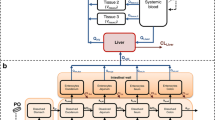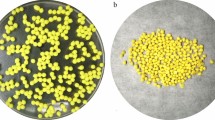ABSTRACT
Purpose
To quantitate and predict colon-specific 9-aminocamptothecin (9-AC) release from the N-(2-hydroxypropyl)methacrylamide (HPMA) copolymer–9-AC conjugate and its absorption behavior after oral administration in rats.
Methods
Drug distribution in the gastrointestinal (GI) tract and the plasma concentration-time profile of 9-AC released from the HPMA copolymer conjugate were predicted using the degradation, transit, and absorption rate constants in cecum. The fate of 9-AC in cecum and liver was measured by in-situ cecum absorption and liver perfusion.
Results
Following oral administration of the conjugate, 9-AC was released rapidly in cecum. Based on the pharmacokinetic model, up to 60% of the dose was in the cecum at ~6 h, and 7% of the dose still remained there at 24 h. The predicted plasma concentration curve for released 9-AC after an oral dose of 3 mg/kg of 9-AC equivalent increased gradually and reached a peak of 98 nM at 7 h, then started decreasing slowly to 16 nM at 24 h. The bioavailability value was estimated as 0.31 after the first-pass elimination.
Conclusions
A pharmacokinetic model delineated the impact of GI transit, drug absorption rate, and first-pass metabolism on drug disposition following oral administration of HPMA copolymer–9-AC conjugate in rats.








Similar content being viewed by others
REFERENCES
J. J. Champoux. Mechanism of the reaction catalyzed by the DNA untwisting enzyme: attachment of the enzyme to 3’-terminus of the nicked DNA. J. Mol. Biol 118:441–446 (1978).
Y. H. Hsiang, and L. F. Liu. Identification of mammalian DNA topoisomerase I as an intracellular target of the anticancer drug camptothecin. Cancer Res 48:1722–1726 (1988).
Y. P. Tsao, A. Russo, G. Nyamuswa, R. Silber, and L. F. Liu. Interaction between replication forks and topoisomerase I-DNA cleavable complexes: studies in a cell-free SV40 DNA replication system. Cancer Res 53:5908–5914 (1993).
Y. P. Tsao, P. D’Arpa, and L. F. Liu. The involvement of active DNA synthesis in camptothecin-induced G2 arrest: altered regulation of p34cdc2/cyclin B. Cancer Res 52:1823–1829 (1992).
C. J. Gerrits, M. J. de Jonge, J. H. Schellens, G. Stoter, and J. Verweij. Topoisomerase I inhibitors: the relevance of prolonged exposure for present clinical development. Brit. J. Cancer 76:952–962 (1997).
P. Pantazis, H. R. Hinz, J. T. Mendoza, A. J. Kozielski, L. J. Williams, J. S. Stehlin, and B. C. Giovanella. Complete inhibition of growth followed by death of human malignant melanoma cells in vitro and regression of human melanoma xenografts in immunodeficient mice induced by camptothecins. Cancer Res 52:3980–3987 (1992).
P. Pantazis, A. J. Kozielski, J. T. Mendoza, J. A. Early, H. R. Hinz, and B. C. Giovanella. Camptothecin derivatives induce regression of human ovarian carcinomas grown in nude mice and distinguish between non-tumorigenic and tumorigenic cells in vitro. Int. J. Cancer 53:863–871 (1993).
H. L. McLeod, F. Douglas, M. Oates, R. P. Symonds, D. Prakash, A. G. vander Zee, S. B. Kaye, R. Brown, and W. N. Keith. Topoisomerase I and II activity in human breast, cervix, lung and colon cancer. Int. J. Cancer 59:607–611 (1994).
B. C. Giovanella, J. S. Stehlin, M. E. Wall, M. C. Wani, A. W. Nicholas, L. F. Liu, R. Silber, and M. Potmesil. DNA topoisomerase I-targeted chemotherapy of human colon cancer in xenografts. Science 246:1046–1048 (1989).
C. H. Takimoto. Why drugs fail: of mice and men revisited. Clin. Cancer Res 7:229–230 (2001).
M. N. Kirstein, P. J. Houghton, P. J. Cheshire, L. B. Richmond, A. K. Smith, S. K. Hanna, and C. F. Stewart. Relation between 9-aminocamptothecin systemic exposure and tumor response in human solid tumor xenografts. Clin. Cancer Res 7:358–366 (2001).
C. L. Erickson-Miller, R. D. May, J. Tomaszewski, B. Osborn, M. J. Murphy, J. G. Page, and R. E. Parchment. Differential toxicity of camptothecin, topotecan and 9-aminocamptothecin to human, canine, and murine myeloid progenitors (CFU-GM) in vitro. Cancer Chemother. Pharmacol 39:467–472 (1997).
S.-Q. Gao, Z.-R. Lu, B. Petri, P. Kopečková, and J. Kopeček. Colon-specific 9-aminocamptothecin-HPMA copolymer conjugates containing a 1,6-elimination spacer. J. Control. Release 110:323–331 (2006).
S.-Q. Gao, Z.-R. Lu, P. Kopečková, and J. Kopeček. Biodistribution and pharmacokinetics of colon-specific HPMA copolymer-9-aminocamptothecin conjugate in mice. J. Control. Release 117:179–185 (2007).
S. Haupt, and A. Rubinstein. The colon as a possible target for orally administered peptide and protein drugs. Crit. Rev. Ther. Drug Carrier Syst 19:499–551 (2002).
S. Sakuma, Z.-R. Lu, P. Kopečková, and J. Kopeček. Biorecognizable HPMA copolymer-drug conjugates for colon-specific delivery of 9-aminocamptothecin. J. Control. Release 75:365–379 (2001).
P. Kopečková, R. Rathi, S. Takada, B. Říhová, M. M. Berenson, and J. Kopeček. Bioadhesive N-(2-hydroxypropyl)methacrylamide copolymers for colon-specific drug delivery. J. Control. Release 28:211–222 (1994).
K. Kakemi, H. Sezaki, R. Konishi, T. Kimura, and A. Okita. Effect of bile salts on the gastrointestinal absorption of drugs. II. Mechanism of the enhancement of the intestinal absorption of sulfaguanidine by bile salts. Chem. Pharm. Bull 18:1034–1039 (1970).
L. S. Schanker, P. A. Shore, B. B. Brodie, and C. A. Hogben. Absorption of drugs from the stomach. I. The rat. J. Pharmacol. Exp. Ther 120:528–539 (1957).
S. Mani, L. Iyer, L. Janisch, X. Wang, G. F. Fleming, R. L. Schilsky, and M. J. Ratain. Phase I clinical and pharmacokinetic study of oral 9-aminocamptothecin (NSC-603071). Cancer Chemother. Pharmacol 42:84–87 (1998).
J. Yokoe, N. Iwasaki, S. Haruta, K. Kadono, K. Ogawara, K. Higaki, and T. Kimura. Analysis and prediction of absorption behavior of colon-targeted prodrug in rats by GI-transit-absorption model. J. Control. Release 86:305–313 (2003).
T. Kimura, N. Iwasaki, J. I. Yokoe, S. Haruta, Y. Yokoo, K. I. Ogawara, and K. Hidaki. Analysis and prediction of absorption profile including hepatic first-pass metabolism of N-methyltyramine, a potent stimulant of gastrin release present in beer, after oral ingestion in rats by gastrointestinal-transit-absorption model. Drug Metab. Dispos 28:577–581 (2000).
S. Terris, and D. F. Steiner. Retention and degradation of 125I-insulin by perfused livers from diabetic rats. J. Clin. Inv 57:885–896 (1976).
K. Higaki, and M. Nakano. Stereoselective disposition of S-8666, a novel uricosuric antihypertensive diuretic, and its N-monodemethylated metabolite in a perfused rat liver preparation. Effect of protein binding on the kinetics of S-8666. Drug Metabol. Disp 20:350–355 (1992).
K. S. Pang, and M. Rowland. Hepatic clearance of drugs. I. Theoretical considerations of a “well-stirred” model and a “parallel tube” model. Influence of hepatic blood flow, plasma and blood cell binding, and the hepatocellular enzymatic activity on hepatic drug clearance. J. Pharmacokin. Biopharm 5:625–653 (1977).
K. S. Pang, and M. Rowland. Hepatic clearance of drugs. II. Experimental evidence for acceptance of the “well-stirred” model over the “parallel tube” model using lidocaine in the perfused rat liver in situ preparation. J. Pharmacokin. Biopharm 5:655–680 (1977).
K. Cheung, P. E. Hickman, J. M. Potter, N. I. Walker, M. Jericho, R. Haslam, and M. S. Roberts. An optimized model for rat liver perfusion studies. J. Surg. Res 66:81–89 (1966).
J. Fassberg, and V. J. Stella. A kinetic and mechanistic study of the hydrolysis of camptothecin and some analogues. J Pharm. Sci 81:676–684 (1992).
C. H. Takimoto, R. W. Klecker, W. L. Dahut, L. K. Yee, J. M. Strong, C. J. Allegra, and J. L. Grem. Analysis of the active lactone form of 9-aminocamptothecin in plasma using solid-phase extraction and high-performance liquid chromatography. J. Chromatogr. B. Biomed. Appl 655:97–104 (1994).
A. Nagashima, E. Tanaka, S. Inomata, K. Honda, and S. Misawa. A study of the in vitro interaction between lidocaine and premedications using human liver microsomes. J. Clin. Pharm. Ther 30:185–188 (2005).
B. Davies, and T. Morris. Physiological parameters in laboratory animals and humans. Pharm. Res 10:1093–1095 (1993).
T. Sawamoto, S. Haruta, Y. Kurosaki, K. Higaki, and T. Kimura. Prediction of the plasma concentration profiles of orally administered drugs in rats on the basis of gastrointestinal transit kinetics and absorbability. J. Pharm. Pharmacol 49:450–457 (1997).
A. Rubinstein. Approaches and opportunities in colon-specific drug delivery. Crit. Rev. Ther. Drug Carrier Syst 12:101–149 (1995).
K. Ikesue, P. Kopečková, and J. Kopeček. Degradation of proteins by guinea pig intestinal enzymes. Int. J. Pharm 95:171–179 (1993).
M. Saffran, G. S. Kumar, C. Savariar, J. C. Burnham, F. Williams, and D. C. Neckers. A new approach to the oral administration of insulin and other peptide drugs. Science 233:1081–1084 (1986).
D. R. Friend, S. Phillips, and T. N. Tozer. Colon-specific drug delivery from a glucoside in the guinea pig. Efficacy study. J. Control. Release 15:47–54 (1991).
C. Larsen, E. Harboe, M. Johansen, and H. P. Oleson. Macromolecular prodrugs. XV. Colon-targeted delivery—comparison of the rate of release of naproxen from dextran ester prodrugs in homogenates of various segments of the pig gastrointestinal tract. Pharm. Res 6:995–999 (1989).
T. Minko. Drug targeting to the colon with lectins and neoglycoconjugates. Adv. Drug Delivery Rev 56:491–509 (2004).
J. P. Brown, G. V. McGarraugh, T. M. Parkinson, R. E. Wingard Jr, and A. B. Oderdonk. A polymeric drug for treatment of inflammatory bowel disease. J. Med. Chem 26:1300–1307 (1983).
S. Wróblewski, M. Berenson, P. Kopečková, and J. Kopeček. Biorecognition of HPMA copolymer–lectin conjugates as an indicator of differentiation of cell-surface glycoproteins in development, maturation, and diseases of human and rodent gastrointestinal tract. J. Biomed. Mater. Res 51:329–342 (2000).
S. Wróblewski, P. Kopečková, B. Říhová, and J. Kopeček. Lectin–HPMA copolymer conjugates: potential oral drug carriers for targeting diseased tissues. Macromol. Chem. Phys 199:2601–2608 (1998).
Z.-R. Lu, S. Gao, P. Kopečková, and J. Kopeček. Synthesis of bioadhesive lectin–HPMA copolymer–cyclosporin conjugates. Bioconjugate Chem 11:3–7 (2000).
S. Wróblewski, B. Říhová, P. Rossmann, T. Hudcovicz, Z. Řeháková, P. Kopečková, B. Říhová, and J. Kopeček. The influence of colonic microbiota on HPMA copolymer–lectin conjugates binding in rodent intestine. J. Drug Targeting 9:85–94 (2001).
T. Kimura, and K. Higaki. Gastrointestinal transit and drug absorption. Biol. Pharm. Bull 25:149–164 (2002).
S. Haupt, T. Zioni, I. Gati, J. Kleinstern, and A. Rubinstein. Luminal delivery and dosing consideration to colorectal cancer. Eur. J. Pharm. Sci 28:204–211 (2006).
G. Chirico, M. Collini, F. Olivini, M. Zamai, E. Frigerio, and V. R. Caiolfa. Aggregation properties of a HPMA-camptothecin copolymer in isotonic solutions. Biophys. Chem 110:281–295 (2004).
E. Gupta, V. Vyas, F. Ahmed, P. Sinko, T. Cook, and E. Rubin. Pharmacokinetics of orally administered camptothecins. Ann. New York Acad. Sci 922:195–204 (2000).
J. R. Gillette. Overview of drug-protein binding. Ann. New York Acad. Sci 226:6–17 (1973).
L. Shargel and A. Yu. Appl. Biopharm. Pharmacokin. McGraw-Hill, pp. 383–393 (1999).
J. M. Gallo, P. Vicini, A. Orlansky, S. Li, F. Zhou, J. Ma, S. Pulfer, M. A. Bookman, and P. Guo. Pharmacokinetic model-predicted anticancer drug concentrations in human tumors. Clin. Cancer Res 10:8048–8058 (2004).
ACKNOWLEDGMENT
The research was supported in part by NIH grants GM50839 and CA51578. 9-Aminocamptothecin was kindly provided by National Cancer Institute, Division of Cancer Treatment and Diagnosis.
Author information
Authors and Affiliations
Corresponding author
Rights and permissions
About this article
Cite this article
Gao, SQ., Sun, Y., Kopečková, P. et al. Pharmacokinetic Modeling of Absorption Behavior of 9-Aminocamptothecin (9-AC) Released from Colon-specific HPMA Copolymer–9-AC Conjugate in Rats. Pharm Res 25, 218–226 (2008). https://doi.org/10.1007/s11095-007-9465-3
Received:
Accepted:
Published:
Issue Date:
DOI: https://doi.org/10.1007/s11095-007-9465-3




